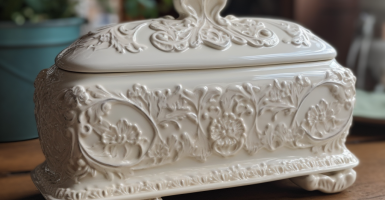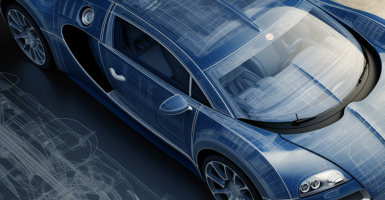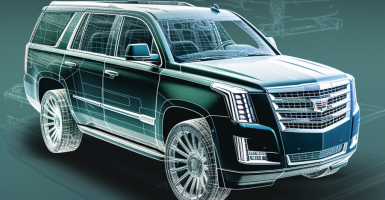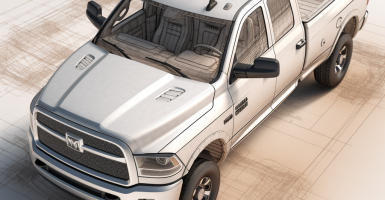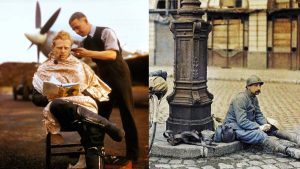Is Buying One Of These Classic Cars On Your Bucket List?
From intimidating muscle cars to lavish phaetons from the 1920s, America has seen some truly amazing automobiles throughout the last century.
You may encounter some of these automobiles at a car museum, but spotting these rare gems on public roads is virtually impossible.
If given a chance, we would very much be willing to drive off in any of them for even 10 minutes of peace and quiet. Read on to see if your “bucket list” ride made the list here.
Ford Mustang

The Mustang is perhaps the most iconic American car of all time. The legendary pony car has been a vital part of American culture ever since its initial debut in the mid-60s.
The original Ford Mustang came with a weak 120-horsepower flat-six under the hood, though most buyers chose to upgrade to one of the optional V8 motors. The most powerful variant produces 271 horses from its 289-cubic inch powerplant.
Chevrolet Corvette C1

The Corvette is often referred to as America’s first sports car. Back when this two-door roadster debuted in the 50s, it was unlike any other vehicle available on the US market at the time.
The original Corvette was nothing like the sports car we know today, though. In fact, the ’53 Vette was so poorly built that the model was nearly discontinued by GM.
Dodge Charger Daytona

Dodge developed this hardcore race car based on the Charger for the ’69 NASCAR season. It was incredibly successful, to say the least.
The Charger Daytona obliterated the competition, all thanks to its unique aerodynamic kit that has been legendary ever since. The success was short-lived, however. NASCAR officials ended up banning aero kits on cars powered by engines larger than 305 cubic inches by 1970.
Duesenberg Model J

The Duesenberg Model J is perhaps the best-known American luxury vehicle sold before World War 2. This land yacht came powered by an enormous 420-cubic inch flat-eight cylinder motor, mated with a 3-speed stick shift.
Duesenberg offered a supercharged variant of the car, called the SJ, for the wealthiest buyers. The model remained on the market until 1937 when the automaker went bankrupt.
Ford Bronco

A classic first-gen Ford Bronco remains a dream car for most off-roader fans. This boxy SUV first hit the market in the second half of the 60s as an alternative to the Jeep CJ-5.
The base model came fitted with a flat-six beneath the hood, though buyers could always upgrade to a more powerful V8 motor. The Bronco was a hit, it was available on the market all the way through the ’90s.
DeLorean DMC-12

A DeLorean was definitely a poster car for anyone who grew up in the 1980s. The car rose to fame shortly after being portrayed as a time machine in Back To The Future.
In reality, however, the DeLorean DMC-12 is quite a controversial vehicle. Its awfully underpowered engine is perhaps the worst downside of the car, followed by poor handling and low build quality. It does look stunning, though.
Chevrolet Corvette C2

1963 is one of the most crucial years in the history of the Chevy Corvette. The C2 generation of America’s first sports car debuted that year, marking a major milestone in automotive history.
Also, ’63 was the only year that the second-gen Corvette came with a gorgeous “split window” back glass design. Chevrolet only sold around 20,000 units that year, making it very sought-after by collectors today.
Shelby Cobra

The Cobra was born after Carroll Shelby decided to throw a monstrous Ford V8 motor under the hood of a small sports car developed by British AC Motors. As a result, the Shelby Cobra has gone down in history as one of the best-performing sports cars of its time.
The most hardcore variant of the Shelby Cobra came powered by a 427ci big-block V8, rated at an astounding 485 horsepower. The top speed of the rare Semi-Competition trim is a whopping 185 miles per hour. Extremely impressive back in the 1960s, and still fast by today’s standards.
Buick Riviera Boat Tail

The Riviera was Buick’s luxury car that first hit the market back in the 60s. The production run lasted over 3 decades before the model was eventually discontinued in 1999.
The third-gen Riviera, often referred to as the Boat Tail, is arguably the most iconic one of them all. This intimidating land yacht also packs a gigantic 455-cubic inch V8 rated at 250 horsepower, too.
Jeep Wrangler

This is perhaps the most famous vehicle made by Jeep to date, it debuted back in the mid-’80s. This small two-door SUV was offered either as a regular SUV or a convertible. Its exceptional off-roading capabilities were instantly recognized by petrolheads across the globe.
The original first-gen Wrangler was offered with a flat-four under the hood as standard. Buyers could upgrade to a more powerful flat-six engine, and choose between the two previously mentioned body styles.
Chevrolet Camaro

General Motors unveiled its very own pony car just two years after the debut of the Ford Mustang. The two models have been competing with each other ever since.
The original first-gen Camaro was an instant hit among buyers, not just in the US. In fact, Chevrolet sold over 220,000 units within a year of the car’s 1967 debut. A small chunk of that number was assembled at GM’s plant in Switzerland and sold across Europe.
Ford Model T

The hot rod culture saw its beginning in California in the late 1930s. The Ford Model T has always been the most popular choice for a custom hot rod among petrolheads, mainly because of their relatively affordable price tags.
Hotrodders modified their cars to reduce weight and increase the power output. Back in the early days, most would install a flathead Ford V8, nicknamed the Flatty, beneath the hood.
Chevrolet Corvette C3

It’s safe to say that Chevrolet was on a roll through the 1960s. The all-new third generation of the Corvette hit the market in 1968, just a year after the debut of the first-ever Camaro pony car.
The third-gen Chevy Corvette saw a major visual makeover, as well as modernized drivetrains. The C3 was also the last Corvette to be offered with a big-block motor.
International Harvester Scout

This exceptional off-roader has been criminally underrated for years following its initial debut in the ’60s. Luckily, this capable SUV has risen back to fame at the beginning of the 21st century.
Today, the International Harvester is a popular pick for off-roader projects and resto-mods. The ’79 Harvester photographed above received a brand new motor, a LS3 V8 rated at a whopping 430 horsepower.
Dodge Challenger

To be fair, Dodge was a little late to the pony car game. That’s because both the Chevy Camaro and the Ford Mustang had already been in the market for a few years by the time Dodge unveiled the Challenger.
The automaker offered the R/T, a high-performance trim level, ever since the car’s 1970 introduction. Equipped with the most powerful engine option, the ’70 Challenger R/T could produce 425 horsepower.
Pontiac Firebird Trans Am

Legendary actor Burt Reynolds drove a beautiful ’77 Pontiac Firebird Trans Am in “Smokey and the Bandit”, making it one of the most famous movie cars of all time.
The Trans Am was an optional high-performance package available for the Pontiac Firebird, a muscle car that shared most of its components with the Chevrolet Camaro. Its 6.6L V8 motor produces roughly 200 horsepower.
Dodge Coronet

At first sight, this muscle car can be mistaken for a Dodge Charger. After all, the two models shared many of the same components, including the same B-Body platform. Nonetheless, the Coronet was considered a separate model.
Much like the Charger and the Challengers, buyers had the option of ordering a Dodge Coronet with a 440-cubic inch big-block as well as the 426-cubic inch Hemi. Both engines peaked at roughly 400 horsepower.
Packard Six

Packard essentially became a synonym of luxury in America throughout the early 1900s. The model first hit the market back in 1912. It was offered in a variety of body styles, including a two-door drop-top and a four-door phaeton.
The pre-war design of the Packard Six proved to be outdated by the mid-’40s, hence the model was discontinued in 1947. The automaker eventually went bankrupt a little over a decade later.
Chevrolet Bel Air

The original Chevy Bel-Air is not only an icon of the automotive world but also the 1950s as a whole. This full-size automobile initially debuted in 1950.
Although the car remained on the market until 1980, the units built in the first decade are considered the best. Distinctive styling inside and out is what made the first three generations of the Bel Air legendary.
Ford Thunderbird

The Thunderbird debuted as an answer to the Chevrolet Corvette. Unlike the Corvette, however, the Ford Thunderbird strived to be more of a luxurious drop-top rather than a full-on sports car.
Every single Ford Thunderbird built between 1955 and 1979 came powered by a V8 motor. Ford ended up selling over 16,000 units in the car’s introductory year, more than 50% over the 10,000-unit expectations.
Ford GT40

This is the legendary race car that managed to beat Ferrari at Le Mans in 1966. Not only did the GT40 beat the Italian automaker at the infamous 24 Hour Le Mans Race, but it also went on to dominate motorsports for the next years.
The GT40 is both powerful and tiny. In fact, the 40 in its nameplate refers to the car’s height of just 40 inches.
Shelby Mustang

What could possibly be better than a classic Ford Mustang? A high-performance classic Mustang developed by Carroll Shelby.
The first-ever Shelby Mustang, the ’65 GT350, came powered by a 289-cubic inch V8 motor rated at a little over 300 horses. Buyers could pick between a four-speed stick shift and the optional three-speed automatic. Today, units equipped with the manual transmission are desired by collectors a lot more than autos.
Plymouth ‘Cuda

The name of this classic muscle car has always been confusing. That’s because every ‘Cuda is a Barracuda, but not every third-gen Barracuda is equipped with the optional ‘Cuda package.
The Plymouth ‘Cuda came powered by a 290-horsepower V8 motor as standard, though an optional 425-horsepower big-block Hemi was available for the most demanding buyers. Less than 7,000 ‘Cudas were made in total, and only 108 of them came with the Hemi V8.
Buick GNX

The GNX was a special project developed by Buick and McLaren at the end of the production run of the Buick Grand National in 1987. The car saw a short production run limited to a little over 500 units in total.
The performance of the 300-horsepower Buick GNX was quite impressive, to say the least. In fact, this car is able to sprint to 60 miles per hour in as litlle as 4.6 seconds.
Pontiac GTO Judge

This intimidating muscle car was introduced for the ’69 model year as a special variant based on the Pontiac GTO. The model was developed to compete with the likes of the Plymouth Road Runner.
Plymouth managed to sell less than 7,000 units of the GTO equipped with The Judge package in 1969, making it a rare gem among collectors worldwide.
Cadillac Eldorado

Most people associate the classic Eldorado with Elvis Presley. The legendary musician used to own a glamorous second-gen drop-top Eldorado with a sleek purple paint job.
As the Eldorado was classified as a lavish luxury car, it only made sense for the automaker to offer an enormous big-block V8 under the hood. At least until the 4.1L-powered tenth-gen hit the market in 1979, that is.
Dodge Viper

This is one of the youngest automobiles on our list. Since this hardcore V10-powered sports car hit the market back in the early 1990s, early units have started turning into priceless classics.
The original Dodge Viper came powered by a monstrous 8.0L V10 motor rated at an astounding 400 horsepower. As a result, it can reach 60 miles per hour in just 4.6 seconds. The sports car was only offered with a manual transmission.
Shelby Daytona

The Daytona has gone down in history as one of the most desired American automobiles of all time. Only 6 units of this spartan race car were built in total.
The Shelby Daytona came fitted with a 289-cubic inch V8 motor sourced from Ford. The car peaked at a little under 400 horses, resulting in a 0-60 sprint in roughly 4.4 seconds.
Chevrolet Apache

It may come as a surprise that one of Chevrolet’s most beautiful pickup trucks, the Apache, was only produced for 6 short years. Buyers were offered a flat-six for the base model, as well as
The model debuted in 1955 as a replacement for the Chevy Advance Series. It was also the direct predecessor of the C/K, which hit the market in 1962.
Dodge Charger R/T

Everyone knows about this truly iconic muscle car, no matter what kind of cars they’re into. A classic Dodge Charger R/T is arguably just as legendary as the original Ford Mustang.
The second-gen of the Charger, sold between ’68 and ’70, remains the most desired among collectors. The R/T trim upgraded the powerplant to an enormous 440-cubic inch V8 as standard, with a slightly smaller yet more powerful 426-cubic inch Hemi offered as an extra option.
Chevrolet El Camino

Unibody pickups never really took off. Buyers always seemed to prefer either proper pickup trucks or regular cars, rather than a mix of both. The Chevrolet El Camino, however, was one of the few exceptions.
This unique vehicle first hit the market in the late 1950s. For a couple of years, Chevrolet even offered a high-performance El Camino SS variant, powered by a 454-cubic inch big-block V8 motor.
Cadillac Coupe De Ville

The iconic De Ville hit the market in the late 50s, just a few years after the previously mentioned Eldorado. Cadillac offered the new model either as a two-door coupe, or a four-door with either four or six windows and a hardtop.
The first-gen Cadillac De Ville may only have been on the market for two years, but it has surely made a massive impact on the world of American cars. Naturally, it was powered by a gigantic big-block V8 under the hood.
Chevrolet Chevelle SS 454 LS6

The SS 454 LS6 was an optional package for the Chevy Chevelle that was both rare and pricey. As a result, it was reserved for only the wealthiest and most demanding buyers.
The Chevelle SS 454 LS6 was equipped with a big-block V8 tuned to make over 500 horsepower! Only 20 units were made in total.
Buick Wildcat

The Wildcat was far from the best-selling Buick of all time. In fact, the model was dropped from the lineup in 1970, just five years after its original debut. Luckily, the American automaker decided to send the car off in style.
For 1970, Buick offered the Wildcat with a powerful 455-cubic inch V8 motor beneath the hood. The power output was around 370 horsepower!
Chevrolet Nova SS

To be completely honest, the Chevrolet Nova SS wasn’t exactly a great car. The vehicle was developed as a budget-friendly, entry-level muscle car that anyone could afford.
Don’t let the SS moniker and badging fool you- this was only a visual package for this particular model. Nonetheless, the Chevy Nova did great in terms of sales and has become somewhat of a cult classic.
Ford F-100

Back in 1953, Ford’s flagship half-ton pickup truck turned into the Ford F-100 we all know and love. Today, this pickup truck is adored for its exceptional styling by both classic car lovers and hotrodders.
The second-gen Ford F-Series wasn’t on the market for long. In fact, it was replaced by the succeeding third-gen just three years after its initial debut.
Plymouth Superbird

This is the iconic race car built for the ’70 racing season. The Superbird was developed to be a successor to the unbelievably successful Dodge Charger Daytona that had dominated NASCAR the previous year.
Sadly, NASCAR officials ended up banning aero specs on big-block-powered cars later that year. The exceptional 425-horsepower race car was discontinued within a year of its debut.
Chevrolet Impala

Life does not get much better than cruising down the street in a ’64 Impala. This full-size land yacht has been a cult classic for decades, and it’s no surprise that we can’t get enough of it.
The third generation of the car remains the most iconic one to date. It was sold between 1961 and 1964. The base model came fitted with a rather underwhelming flat-six motor. In its most powerful version, however, the V8-powered ’64 Impala can hit 60 miles per hour in just 5.9 seconds.
